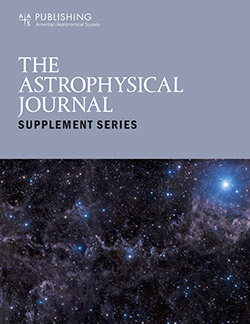银河系星际比18O/17O的系统观测研究。2C18O和C17O J = 2-1数据分析
IF 8.5
1区 物理与天体物理
Q1 ASTRONOMY & ASTROPHYSICS
引用次数: 0
摘要
为了研究高质量恒星与中质量恒星的相对喷射量,并追踪银河系的化学演化,我们利用IRAM 30 m和10 m亚毫米望远镜对421个分子云样本进行了银河系18 O/ 17 O比的系统研究,覆盖了星系中心距离范围为1-22 kpc。本文给出的结果是基于J = 2-1跃迁,包括364个源,显示c18o和c17o检测。先前建议的18 O/ 17 O梯度被确认。对于用这两种设备检测到的41个源,得到了很好的一致性。没有发现18 O/ 17 O比值与日心距离的相关性,表明光束稀释和线性光束尺寸无关。对于具有精确视差距离的IRAM 30 m高质量恒星形成区域的子样本,未加权拟合得到18 O/ 17 O =(0.12±0.02)R GC +(2.38±0.13),相关系数R = 0.67。虽然斜率与我们的J = 1-0测量结果一致,但比率系统性地降低了。这应该引起更大的光学深度C 18 O 2 - 1线对应的1 - 0转换,由RADEX支持计算17和18 O / C O与13 CO / C 18 O .呈正相关,当我们考虑到光学深度影响C 18 O J = 2:1通常达成光学深度0.5∼,纠正17 18 O / O比率从J = 1 - 0和J = 2行是一致的。MWG-12模型提供了一个很好的数值拟合数据,其中包括旋转恒星和新星。本文章由计算机程序翻译,如有差异,请以英文原文为准。
A Systematic Observational Study on Galactic Interstellar Ratio 18O/17O. II. C18O and C17O J = 2–1 Data Analysis
Abstract To investigate the relative amount of ejecta from high-mass versus intermediate-mass stars and to trace the chemical evolution of the Galaxy, we have performed a systematic study of Galactic interstellar 18 O/ 17 O ratios toward a sample of 421 molecular clouds with IRAM 30 m and the 10 m Submillimeter Telescope, covering a galactocentric distance range of ∼1–22 kpc. The results presented in this paper are based on the J = 2–1 transition and encompass 364 sources showing both C 18 O and C 17 O detections. The previously suggested 18 O/ 17 O gradient is confirmed. For the 41 sources detected with both facilities, good agreement is obtained. A correlation of the 18 O/ 17 O ratios with heliocentric distance is not found, indicating that beam dilution and linear beam sizes are not relevant. For the subsample of IRAM 30 m high-mass star-forming regions with accurate parallax distances, an unweighted fit gives 18 O/ 17 O = (0.12 ± 0.02) R GC + (2.38 ± 0.13) with a correlation coefficient of R = 0.67. While the slope is consistent with our J = 1–0 measurement, the ratios are systematically lower. This should be caused by larger optical depths of C 18 O 2–1 lines with respect to the corresponding 1–0 transitions, which is supported by RADEX calculations and the fact that C 18 O/C 17 O is positively correlated with 13 CO/C 18 O. When we consider that optical depth effects with C 18 O J = 2–1 typically reach an optical depth of ∼0.5, the corrected 18 O/ 17 O ratios from the J = 1–0 and J = 2–1 lines are consistent. A good numerical fit to the data is provided by the MWG-12 model, which includes both rotating stars and novae.
求助全文
通过发布文献求助,成功后即可免费获取论文全文。
去求助
来源期刊

Astrophysical Journal Supplement Series
地学天文-天文与天体物理
CiteScore
14.50
自引率
5.70%
发文量
264
审稿时长
2 months
期刊介绍:
The Astrophysical Journal Supplement (ApJS) serves as an open-access journal that publishes significant articles featuring extensive data or calculations in the field of astrophysics. It also facilitates Special Issues, presenting thematically related papers simultaneously in a single volume.
 求助内容:
求助内容: 应助结果提醒方式:
应助结果提醒方式:


